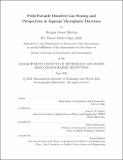Field-Portable Dissolved Gas Sensing and Perspectives in Aqueous Microplastic Detection
Author(s)
Blevins, Morgan Grace
DownloadThesis PDF (20.19Mb)
Advisor
Michel, Anna P. M.
Terms of use
Metadata
Show full item recordAbstract
Global temperature rise and increased atmospheric carbon dioxide (CO2) levels have affected the health of the world’s ocean and water ecosystems, impacting the balances of natural carbon cycling and causing ocean acidification. Additionally, as global temperatures rise, thawing permafrost has stimulated increased release of methane (CH4), a gas with a shorter lifetime in the atmosphere but with even more heat trapping ability than CO2. In situ analysis of dissolved gas content in surface waters is currently performed with large, expensive instruments, such as spectrometers, which are coupled with gas equilibration systems, which extract dissolved gas from water and feed it to the sensor. Accurate, low cost, and portable sensors are needed to measure the dissolved CH4 and CO2 concentration in water systems to quantify their release and understand their relationship to the global carbon budget. At the same time, while greenhouse gases are well established threats to water ecosystems, the ubiquity and potential consequences of microplastics in aqueous environments are just beginning to be recognized by the environmental research community. Microplastics (MPs) are small particles of polymer debris, commonly defined as being between 1 µm and 1000 µm. Despite the pervasiveness of MPs, our ability to characterize MPs in the environment is limited by the lack of technologies for rapidly and accurately identifying and quantifying MPs. This thesis is concerned with the engineering challenges prompted by the need for high quality and quantity environmental data to better study and the impact, cycling, and prevalence of these pollutants in aqueous environments.
Three distinct investigations are presented here. First, the design of the LowCost Gas Extraction and Measurement System (LC-GEMS) for dissolved CO2 is presented. At just under $600 dollar to build, the LC-GEMS is an ultra-portable, toolbox-sized instrument for dissolved gas sensing in near-surface waters. The LCGEMS was characterized in the lab and demonstrated linear relationships with dissolved CO2 as well as temperature. Lab calibrations and subsequent field testing in the Little Sippewissett Marsh, in Falmouth, Massachusetts showed that the LCGEMS captures both diurnal and minute-time scale trends in dissolved CO2.
Second, this thesis presents the novel design of three simple and low-cost planar nanophotonic and plasmonic structures as optical transducers for measuring dissolved CH4. Through simulations, the sensitivity of the structures are evaluated and found to exhibit superior performance in the reflectance intensity readout mode to that of the standard surface-plasmon-polariton-mode Spreeta sensor. A practical, small, and low-cost implementation of this chip with a simple intensity-based measurement scheme is proposed. This design is novel in the space of dissolved gas monitoring because it shows potential to measure directly in the water phase while being robust and low-cost to implement.
Finally, this thesis presents a literature review and perspective to motivate the development of field-deployable microplastic sensing techniques. A framework for field-deployable microplastic sensing is presented and seeks to inform the MP community of the potential in both traditional MP analysis techniques and unconventional methods for creating rapid and automated MP sensors. The field-deployabilty framework addresses a full scope of practical/technological trade-offs to be considered for portable MP detection.
Date issued
2021-06Department
Massachusetts Institute of Technology. Department of Aeronautics and AstronauticsPublisher
Massachusetts Institute of Technology